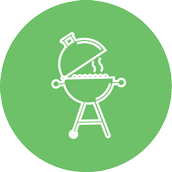Processing
The word “processed” often causes some confusion, so let me clarify what I mean. Obviously, most foods we eat are processed in some way. Apples are cut from trees, ground beef has been ground in a machine and butter is cream that has been separated from the milk and churned. But there is a difference between mechanical processing and chemical processing. If it’s a single ingredient food with no added chemicals, then it doesn’t matter if it’s been ground or put into a jar. It’s still real food.
However… foods that have been chemically processed and made solely from refined ingredients and artificial substances, are what is generally known as “processed food.”
Processed meat is generally considered unhealthy. However, meat that has been frozen or undergone mechanical (minimal) processing like cutting and slicing is still considered unprocessed. There is no doubt that highly (chemically) processed meat contains many harmful chemicals that are not naturally present in fresh meat.
Here are 9 ways that highly (chemically) processed foods are bad for your health.
- Processed Foods Are Usually High in Sugar and High Fructose Corn Syrup
- Processed Foods Are “Hyper Rewarding” and Lead to Overconsumption
- Processed Foods Contain All Sorts of Artificial Ingredients
- Many People Can Literally Become Addicted to Processed Junk Foods
- Processed Foods Are Often High in Refined Carbohydrates
- Most Processed Foods Are Low in Nutrients
- Processed Foods Tend to be Low in Fiber
- It Requires Less Energy and Time to Digest Processed Foods
- Processed Foods Are Often High in Trans Fats or Processed Vegetable Oils
Manufacturers Seeking Natural Ways to Extend Foods’ Shelf Life
Keeping food fresh, safe and appealing is the ultimate goal of any food manufacturer, but there are new challenges now that clean, free-from ingredients and minimal processing are in such high demand.
With the trend toward clean labels, consumers are carefully checking ingredient lists to find the fewest or safest-sounding ingredients and the least amount of “processing.” One of the most difficult challenges in that regard is to find natural ways to extend shelf life. Shelf life isn’t just a way to track days or weeks on a store shelf; it involves microbial activity, mold/yeast development, lipid oxidation, flavor, aroma and color as well as usability at home. A food’s shelf life relies on such factors as the type of process and formulation involved, the packaging used and storage conditions. But in the end, shelf life extension involves additives.



